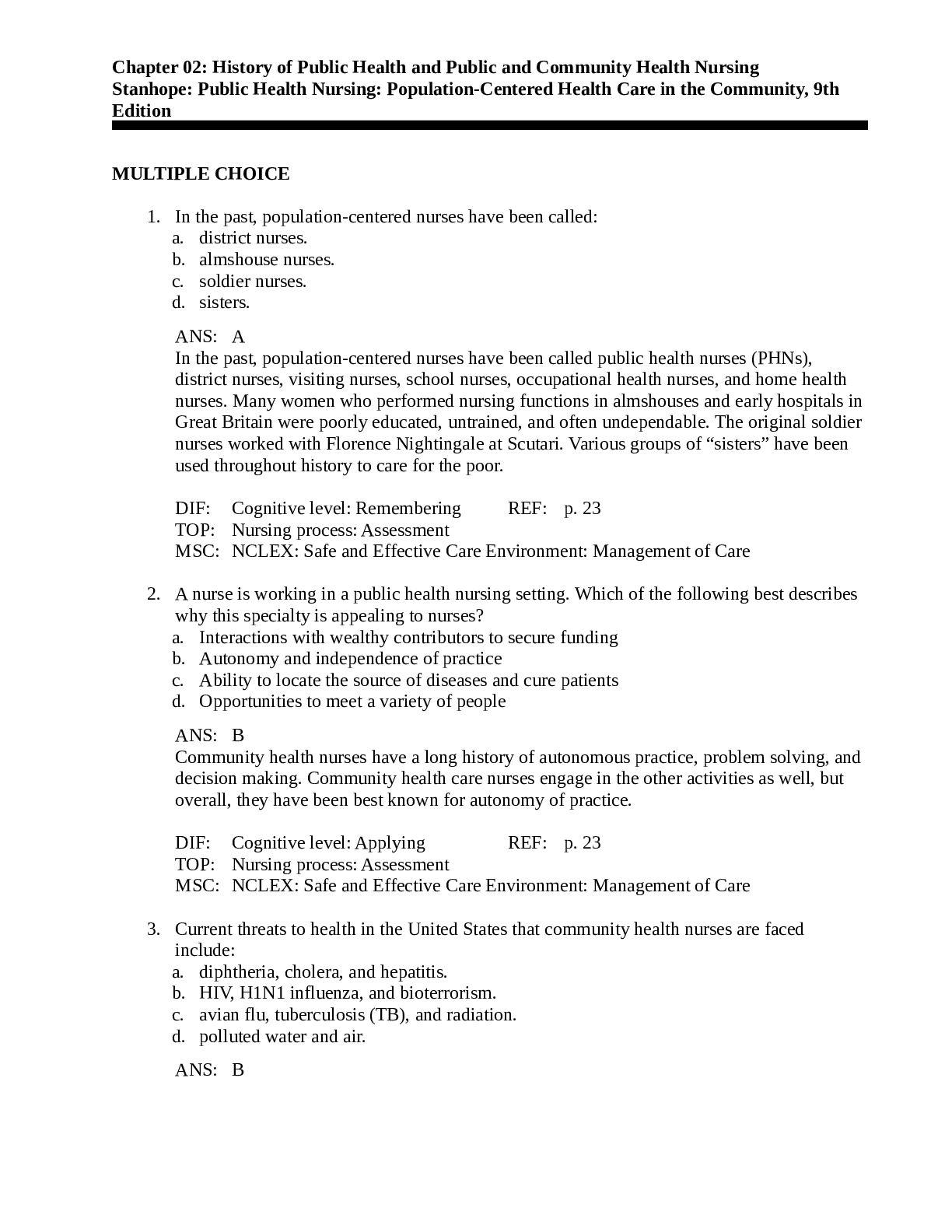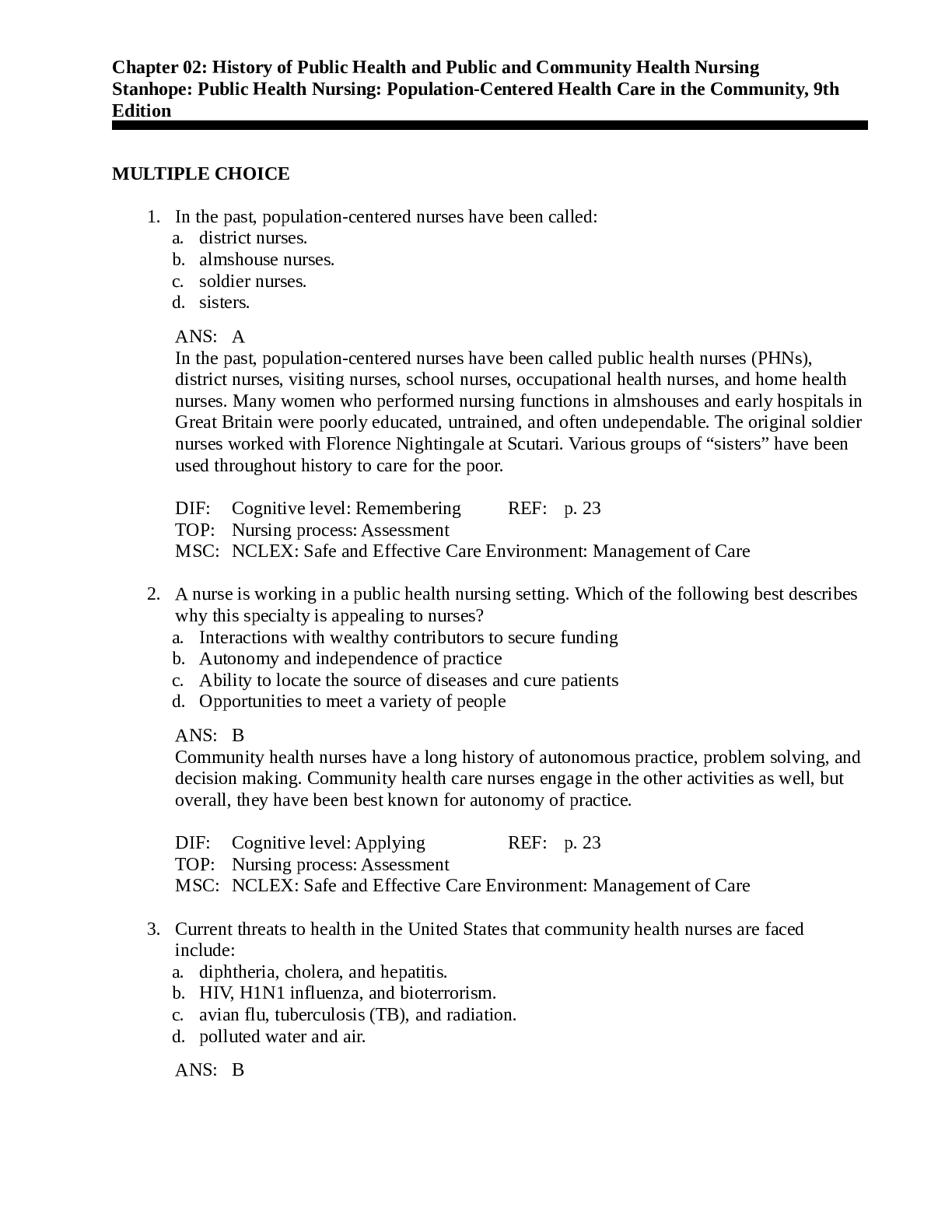MULTIPLE CHOICE
1. In the past, population-centered nurses have been called:
a. district nurses.
b. almshouse nurses.
c. soldier nurses.
d. sisters.
ANS: A
In the past, population-centered nurses have been called public health nurses (PHNs),
district nurses, visiting nurses, school nurses, occupational health nurses, and home health
nurses. Many women who performed nursing functions in almshouses and early hospitals in
Great Britain were poorly educated, untrained, and often undependable. The original soldier
nurses worked with Florence Nightingale at Scutari. Various groups of “sisters” have been
used throughout history to care for the poor.
DIF: Cognitive level: Remembering REF: p. 23
TOP: Nursing process: Assessment
MSC: NCLEX: Safe and Effective Care Environment: Management of Care
2. A nurse is working in a public health nursing setting. Which of the following best describes
why this specialty is appealing to nurses?
a. Interactions with wealthy contributors to secure funding
b. Autonomy and independence of practice
c. Ability to locate the source of diseases and cure patients
d. Opportunities to meet a variety of people
ANS: B
Community health nurses have a long history of autonomous practice, problem solving, and
decision making. Community health care nurses engage in the other activities as well, but
overall, they have been best known for autonomy of practice.
DIF: Cognitive level: Applying REF: p. 23
TOP: Nursing process: Assessment
MSC: NCLEX: Safe and Effective Care Environment: Management of Care
3. Current threats to health in the United States that community health nurses are faced
include:
a. diphtheria, cholera, and hepatitis.
b. HIV, H1N1 influenza, and bioterrorism.
c. avian flu, tuberculosis (TB), and radiation.
d. polluted water and air.
ANS: B
The newest threats to health that PHNs are involved in are HIV, H1N1 influenza, and
bioterrorism. Hepatitis is also a current threat, but diphtheria and cholera are not concerns in
the United States. Avian flu may be a threat, but radiation and TB are ongoing.
Environmental pollution has been reduced; however, there are pollution issues that do raise
concerns.
DIF: Cognitive level: Understanding REF: p. 23
TOP: Nursing process: Assessment
MSC: NCLEX: Safe and Effective Care Environment: Management of Care
4. A nurse is working to reform a program that was based on the Elizabethan Poor Law of
1601. Which of the following programs is the nurse most likely working on?
a. Welfare
b. Food Stamps
c. Medicaid
d. Medicare
ANS: C
The Poor Law guaranteed medical care for poor, blind, and “lame” individuals, making it
most similar to Medicaid since this program provides medical insurance to these types of
individuals. Welfare provides more than health care. Food stamps do not provide medical
care. The Medicare program provides medical care to the elderly population.
DIF: Cognitive level: Analyzing REF: p. 24
TOP: Nursing process: Implementation
MSC: NCLEX: Safe and Effective Care Environment: Management of Care
5. In early colonial North America, a colonist worked in the public health sector. Which of the
following would have most likely been the focus?
a. Establishing schools of nursing
b. Developing vaccines to administer to large numbers of people
c. Collecting vital statistics and improving sanitation
d. Developing public housing and almshouses
ANS: C
The early colonial public health efforts included the collection of vital statistics,
improvements to sanitation systems, and control of communicable disease introduced
through seaports. Establishing schools of nursing, developing vaccines, and developing
public housing are all events that happened after the colonial period.
DIF: Cognitive level: Applying REF: p. 24
TOP: Nursing process: Assessment
MSC: NCLEX: Health Promotion and Maintenance
6. A nurse was employed by the Marine Hospital Service. Which of the following tasks would
have most likely been the responsibility of the nurse?
a. Setting policy on quarantine legislation for immigrants
b. Establishing hospital-based programs to care for the sick at home
c. Identifying and improving environmental conditions
d. Providing health care for merchant seamen
Read More


